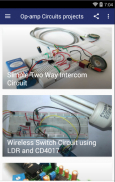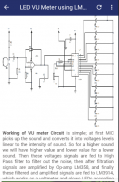








Op-amp Circuits projects

คำอธิบายของOp-amp Circuits projects
Op-amp Circuits projects
An operational amplifier (often op-amp or opamp) is a DC-coupled high-gain electronic voltage amplifier with a differential input and, usually, a single-ended output.[1] In this configuration, an op-amp produces an output potential (relative to circuit ground) that is typically hundreds of thousands of times larger than the potential difference between its input terminals. Operational amplifiers had their origins in analog computers, where they were used to perform mathematical operations in many linear, non-linear, and frequency-dependent circuits.
The popularity of the op-amp as a building block in analog circuits is due to its versatility. By using negative feedback, the characteristics of an op-amp circuit, its gain, input and output impedance, bandwidth etc. are determined by external components and have little dependence on temperature coefficients or manufacturing variations in the op-amp itself.
Op-amps are among the most widely used electronic devices today, being used in a vast array of consumer, industrial, and scientific devices. Many standard IC op-amps cost only a few cents in moderate production volume; however, some integrated or hybrid operational amplifiers with special performance specifications may cost over US$100 in small quantities.[2] Op-amps may be packaged as components or used as elements of more complex integrated circuits.
The op-amp is one type of differential amplifier. Other types of differential amplifier include the fully differential amplifier (similar to the op-amp, but with two outputs), the instrumentation amplifier (usually built from three op-amps), the isolation amplifier (similar to the instrumentation amplifier, but with tolerance to common-mode voltages that would destroy an ordinary op-amp), and negative-feedback amplifier (usually built from one or more op-amps and a resistive feedback network)
โครงการสหกรณ์แอมป์วงจร
เครื่องขยายเสียงในการดำเนินงาน (มัก OpAmp หรือ opamp) เป็นกำไรสูงเครื่องขยายเสียงแรงดันไฟฟ้าอิเล็กทรอนิกส์ DC-ควบคู่ไปกับการป้อนข้อมูลที่แตกต่างกันและมักจะเป็นเอาท์พุทเดียวจบ. [1] ในการกำหนดค่านี้สหกรณ์แอมป์ผลิตที่มีศักยภาพการส่งออก (เทียบกับพื้นดินวงจร) ที่เป็นปกติหลายร้อยหลายพันครั้งใหญ่กว่าความแตกต่างที่อาจเกิดขึ้นระหว่างขั้วอินพุต เครื่องขยายเสียงในการดำเนินงานมีต้นกำเนิดของพวกเขาในแอนะล็อกคอมพิวเตอร์ที่พวกเขาถูกนำมาใช้ในการดำเนินการทางคณิตศาสตร์ในเชิงเส้นหลาย ๆ ที่ไม่ใช่เชิงเส้นและวงจรขึ้นอยู่กับความถี่
ความนิยมของสหกรณ์แอมป์เป็นอาคารบล็อกในวงจรอนาล็อกเป็นเพราะความเก่งกาจของ โดยใช้ความคิดเห็นเชิงลบลักษณะของวงจรสหกรณ์แอมป์ที่ได้รับเข้าและส่งออกของความต้านทานแบนด์วิดท์ ฯลฯ จะถูกกำหนดโดยส่วนประกอบภายนอกและมีการพึ่งพาอาศัยกันเล็ก ๆ น้อย ๆ เกี่ยวกับค่าสัมประสิทธิ์อุณหภูมิหรือรูปแบบการผลิตในสหกรณ์แอมป์ตัวเอง
สหกรณ์แอมป์เป็นหนึ่งในอุปกรณ์อิเล็กทรอนิกส์ที่ใช้กันอย่างแพร่หลายมากที่สุดในวันนี้ถูกนำมาใช้ในหลากหลายของผู้บริโภคอุตสาหกรรมและอุปกรณ์ทางวิทยาศาสตร์ หลายมาตรฐาน IC สหกรณ์แอมป์ค่าใช้จ่ายเพียงไม่กี่เซ็นต์ในปริมาณการผลิตในระดับปานกลาง แต่บางเครื่องขยายการดำเนินงานแบบบูรณาการหรือไฮบริดที่มีคุณสมบัติพิเศษประสิทธิภาพการทำงานอาจมีค่าใช้จ่ายมากกว่า $ 100 US ในปริมาณที่น้อย. [2] สหกรณ์แอมป์อาจจะบรรจุเป็นส่วนประกอบหรือใช้เป็นองค์ประกอบของวงจรรวมที่ซับซ้อนมากขึ้น
สหกรณ์แอมป์เป็นหนึ่งในประเภทของเครื่องขยายเสียงที่แตกต่างกัน ประเภทอื่น ๆ ของเครื่องขยายเสียงที่แตกต่างกันรวมถึงเครื่องขยายเสียงที่แตกต่างกันอย่างเต็มที่ (คล้ายกับสหกรณ์แอมป์ แต่มีสองเอาท์พุท), เครื่องขยายเสียงวัด (มักจะสร้างขึ้นจากสามสหกรณ์แอมป์), เครื่องขยายเสียงแยก (คล้ายกับเครื่องขยายเสียงวัด แต่ด้วยความอดทน แรงดันไฟฟ้าทั่วไปโหมดที่จะทำลายสามัญสหกรณ์แอมป์) และเครื่องขยายเสียงลบความคิดเห็น (มักจะสร้างขึ้นจากหนึ่งหรือมากกว่าสหกรณ์แอมป์และเครือข่ายข้อเสนอแนะทาน)


























